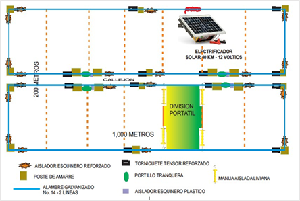Silvopastoral systems for livestock production at the Limón Rocío Production Center of the UNSM-T
DOI:
https://doi.org/10.51252/revza.v2i2.398Keywords:
pastures, agrosilvopastoral system, legumes, plant successionAbstract
For adequate livestock development, there must be a point of balance between animal production and environmental services. The objective of the study was to carry out agronomic evaluations in four silvopastoral systems (SSP). To do this, 16 ha of pastures were installed (pasture system alone with Brachiaria brizanta; plant succession management system; pasture system with shrub legumes; and systems such as energy and protein banks) in a tropical dry forest ecosystem in the San Martín region, Peru, in a period of five months. The result of the agronomic evaluations showed that the behavior of the introduced forage species, both grasses used as cover and cut grass, as well as shrubby legumes used as living fences; the nutritional evaluation in terms of dry matter (DM), neutral detergent fiber (NDF) and total protein, carried out 120 days after sowing, did not find significant differences (p<0.05), in the SSP with coverage of Brachiaria brizantha, showing that at this age of the pastures effects of the four different systems evaluated are not yet observed; in the forage species introduced in the SSP, a great variability was found in the nutritional indices evaluated.
Downloads
References
Arrieta Herrera, J. M. (2004). Aspectos sobre el control de malezas compuestas en pastos dedicados a la ganadería de leche. Ciencia & Tecnología Agropecuaria, 5(1), 76-84. https://doi.org/10.21930/rcta.vol5_num1_art:29
Benavides Salazar, M. F. (2013). Evaluación del impacto socioeconómico de pasturas degradadas en fincas ganaderas de la cuenca media del río Jesús María, Costa Rica [Centro agronómico tropical de investigación y enseñanza ]. https://repositorio.catie.ac.cr/handle/11554/7123
Cabrera-Nuñez, A., Lammoglia-Villadomez, M., Alarcón-Pulido, S., Martinez-Sanchez, C., Rojas-Ronquillo, R., & Velazquez-Jimenez, S. (2019). Árboles y arbustos forrajeros utilizados para la alimentación de ganado bovino en el norte de Veracruz, México. Abanico Veterinario, 9(1). https://doi.org/10.21929/abavet2019.913
Silva, G. (2017). Descripción de gramíneas y leguminosas forrajes tropicales adaptadas a la region San Martin. En Curso: Pastos y Forrajes. Escuela de Medicina Veterinaria - Universidad Nacional de San Martin.
Toledo, J. M. (1982). Manual para la evaluación agronómica : Red internacional de evaluación de pastos tropicales (Primera Edición). Ciat. https://cgspace.cgiar.org/handle/10568/54148
UNSM, & La Molina. (2019). Simposio Internacional “Ganadería y Sistemas Silvopastoriles”. https://unsm.edu.pe/simposio-internacional-ganaderia-y-sistemas-silvopastoriles-realizaran-universidad-nacional-agraria-la-molina-y-universidad-nacional-de-san-martin/
Vargas Barrera, M. G. (2019). Proyecto ganadero va tomando cuerpo. Nota de Prensa. https://www.regionsanmartin.gob.pe/Noticias?url=noticia&id=5791
Velásquez-Veles, R., & Mora-Delgado, J. (2009). Cobertura arbórea y herbácea en pasturas naturalizadas de fincas ganaderas del Trópico Seco de Nicaragua. Revista Colombiana De Ciencias Pecuarias, 21(4), 571-581. https://revistas.udea.edu.co/index.php/rccp/article/view/324329
Zelada Sánchez, E. E. (1996). Tolerancia a la sombra de especies forrajeras herbaceas en la zona atlántica de Costa Rica [Centro Agronómico tropical de investigación y enseñanza]. En CATIE. https://repositorio.catie.ac.cr/handle/11554/10494

Published
How to Cite
Issue
Section
License
Copyright (c) 2022 Roberto Edgardo Roque-Alcarraz, Justo German Silva-Del-Águila, Marvin Barrera-Lozano

This work is licensed under a Creative Commons Attribution 4.0 International License.
The authors retain their rights:
a. The authors retain their trademark and patent rights, as well as any process or procedure described in the article.
b. The authors retain the right to share, copy, distribute, execute and publicly communicate the article published in the Revista de Veterinaria y Zootecnia Amazónica (REVZA) (for example, place it in an institutional repository or publish it in a book), with an acknowledgment of its initial publication in the REVZA.
c. Authors retain the right to make a subsequent publication of their work, to use the article or any part of it (for example: a compilation of their works, notes for conferences, thesis, or for a book), provided that they indicate the source of publication (authors of the work, journal, volume, number and date).

